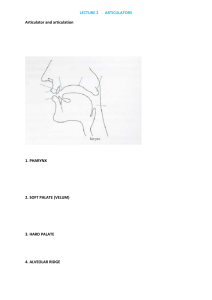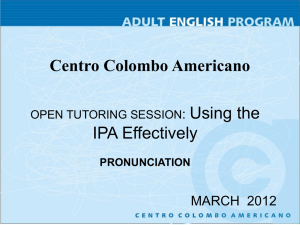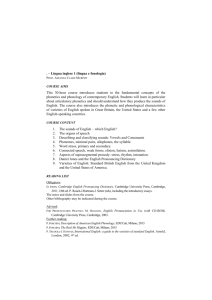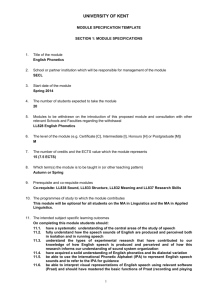Required text
advertisement
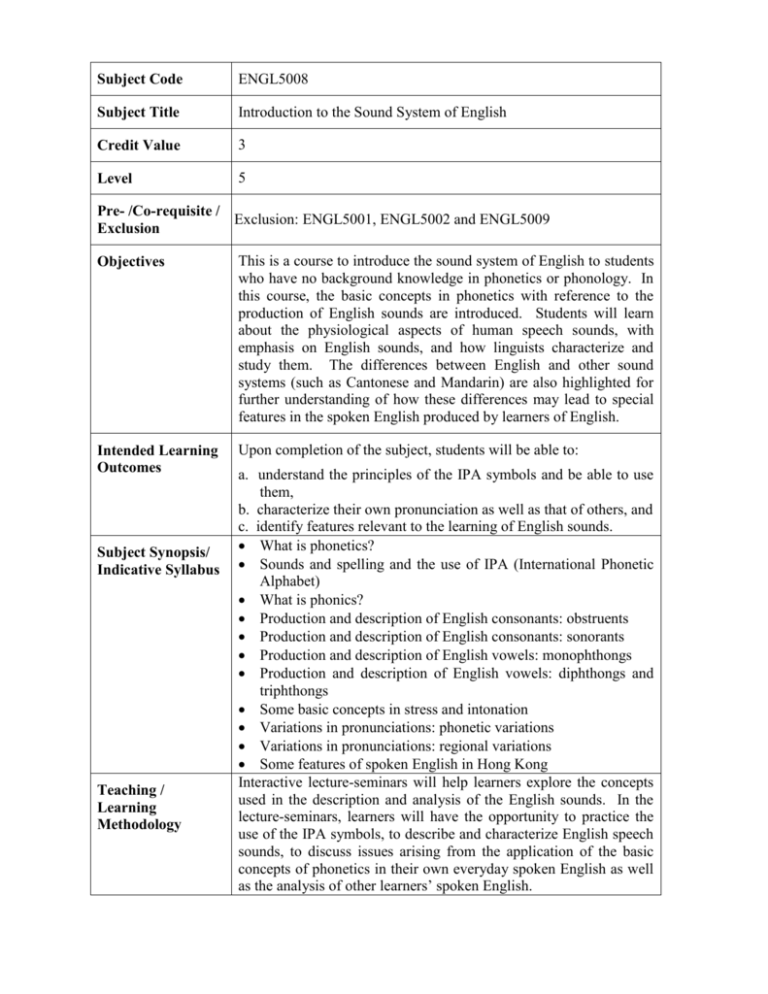
Subject Code ENGL5008 Subject Title Introduction to the Sound System of English Credit Value 3 Level 5 Pre- /Co-requisite / Exclusion: ENGL5001, ENGL5002 and ENGL5009 Exclusion Objectives This is a course to introduce the sound system of English to students who have no background knowledge in phonetics or phonology. In this course, the basic concepts in phonetics with reference to the production of English sounds are introduced. Students will learn about the physiological aspects of human speech sounds, with emphasis on English sounds, and how linguists characterize and study them. The differences between English and other sound systems (such as Cantonese and Mandarin) are also highlighted for further understanding of how these differences may lead to special features in the spoken English produced by learners of English. Intended Learning Outcomes Upon completion of the subject, students will be able to: Subject Synopsis/ Indicative Syllabus Teaching / Learning Methodology a. understand the principles of the IPA symbols and be able to use them, b. characterize their own pronunciation as well as that of others, and c. identify features relevant to the learning of English sounds. What is phonetics? Sounds and spelling and the use of IPA (International Phonetic Alphabet) What is phonics? Production and description of English consonants: obstruents Production and description of English consonants: sonorants Production and description of English vowels: monophthongs Production and description of English vowels: diphthongs and triphthongs Some basic concepts in stress and intonation Variations in pronunciations: phonetic variations Variations in pronunciations: regional variations Some features of spoken English in Hong Kong Interactive lecture-seminars will help learners explore the concepts used in the description and analysis of the English sounds. In the lecture-seminars, learners will have the opportunity to practice the use of the IPA symbols, to describe and characterize English speech sounds, to discuss issues arising from the application of the basic concepts of phonetics in their own everyday spoken English as well as the analysis of other learners’ spoken English. Assessment Methods in Alignment with Intended Learning Outcomes Specific assessment methods/tasks % weighting Intended subject learning outcomes to be assessed a b c 1. An in-class open book quiz 30% 2. A mini project analyzing some authentic English speech 70% Total 100% (1) The in-class quiz will enable learners to use and apply the concepts learned in the subject in a practical sense. (2) The mini-project will enable students to further integrate the skills and concepts in the analysis of authentic data. Student Study Effort Required Class contact: Lecture-seminar (3 hrs x 14 wks) 42 Hrs. Other student study effort: Exercise preparation (2 hr x 14 wks) 28 Hrs. Reading materials (3 hr x 14 wks) 42 Hrs. Total student study effort Reading List and References 112 Hrs. Required text Ashby, Patricia. 2005. Speech Sounds. (2nd Edition). London & New York: Routledge. Highly recommended texts Roach, Peter. 2009. English Phonetics and Phonology (4th Edition). Cambridge: Cambridge University Press. Ladefoged, Peter. 2006. A Course in Phonetics. (5th Edition). Boston, Mass: Thomson Wadsworth. Kreidler, Charles W. 2006. Describing spoken English: an introduction. London: Routledge. Further reading on Teaching Pronunciation Avery, Peter and Susan Ehrlich. 1992. Teaching American English Pronunciation. Oxford: Oxford University Press. Celce-Murcia, Marianne, Donna M. Brinton and Janet M. Goodwin. 1996. Teaching Pronunciation: A Reference for Teachers of English to Speakers of Other Languages. Cambridge, UK: Cambridge University Press. Hancock, Mark. 1995. Pronunciation Games. Cambridge, UK: Cambridge University Press. Selected References on Hong Kong English Chan, A. Y. W., & Li, D. C. S. 2000. English and Cantonese phonology in contrast: explaining Cantonese ESL learners’ English pronunciation problems. Language, Culture and Curriculum. Hung, T. 2000. Towards a phonology of Hong Kong English. World Englishes 19(3): 337-356. Useful Websites International Phonetic Association http://www.langsci.ucl.ac.uk/ipa/ Phonetic Flash http://www.phon.ucl.ac.uk/home/johnm/flash/flashin.htm English sounds with animated demonstration at http://www.uiowa.edu/~acadtech/phonetics/english/frameset.ht ml The OUP website with English sound demonstration http://www.oup.com/elt/global/products/englishfile/englishfile1 /z_pronunciation/ HKPU ELC Pronunciation page http://elc.polyu.edu.hk/CILL/pronunci.htm#Listen%20to%20a %20word Sounds of English http://www.soundsofenglish.org/ Prepared and updated by Cathy S.P. Wong (24 May 2010)
